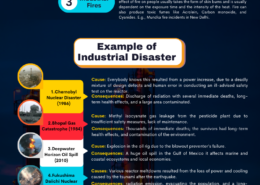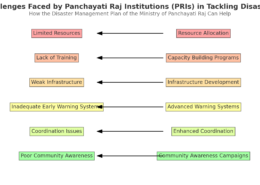Despite the fact that there are many causes of land subsidence, it is crucial to assess the potential impact and develop a long-term strategy to reduce any negative effects. Discuss. (Answer in 250 words)
Infographics about industrial disasters are catastrophic events resulting from industrial activities, leading to significant harm to people, property, and the environment. Notable incidents include the Bhopal gas tragedy, the Deepwater Horizon oil spill, the Chernobyl nuclear disaster, and the FukusRead more
Infographics about industrial disasters are catastrophic events resulting from industrial activities, leading to significant harm to people, property, and the environment. Notable incidents include the Bhopal gas tragedy, the Deepwater Horizon oil spill, the Chernobyl nuclear disaster, and the Fukushima Daiichi nuclear disaster. These events highlight the importance of stringent safety protocols, regular maintenance, and emergency preparedness to prevent future tragedies. Ensuring workplace safety, adopting sustainable practices, and adhering to regulations can mitigate risks and protect communities from industrial hazards.
See less




Land subsidence, or the progressive sinking of land, can be caused by a number of things, such as mining, groundwater extraction, natural sediment compaction, and seismic activity. It presents serious concerns, including the potential for building structural damage, unstable infrastructure, an increRead more
Land subsidence, or the progressive sinking of land, can be caused by a number of things, such as mining, groundwater extraction, natural sediment compaction, and seismic activity. It presents serious concerns, including the potential for building structural damage, unstable infrastructure, an increased danger of flooding, and environmental deterioration. Therefore, evaluating its possible influence is essential to reducing these negative impacts. First off, precise information on subsidence patterns can be obtained by extensive monitoring systems that make use of GPS, satellite photography, and other technologies. Understanding the amount and rate of subsidence as well as forecasting future trends depend heavily on this data. Second, over-extraction-related subsidence can be lessened with the aid of sustainable water management techniques like controlling groundwater extraction and fostering the use of alternate water sources. Sinking regions can also be stabilized by artificially replenishing groundwater. Land subsidence, the gradual sinking of land, can result from various causes, including groundwater extraction, mining, natural compaction of sediments, and seismic activities. It poses significant risks such as structural damage to buildings, infrastructure instability, increased flood risk, and environmental degradation. Hence, assessing its potential impact is critical for mitigating these adverse effects. Thirdly, evaluations of the danger of subsidence must be incorporated into infrastructure development and urban planning. Construction methods and materials that endure the effects of subsidence should be mandated by building regulations and land-use policies. Finally, encouraging community participation in subsidence management programs and increasing public knowledge of the problem can help to unite efforts to resolve it. The negative effects of land subsidence can be successfully reduced by using a comprehensive strategy that incorporates scientific, governmental, and community-based tactics, guaranteeing safer and more resilient landscapes.
See less